Pantex Blog
I am mission success: Michelle Reichert
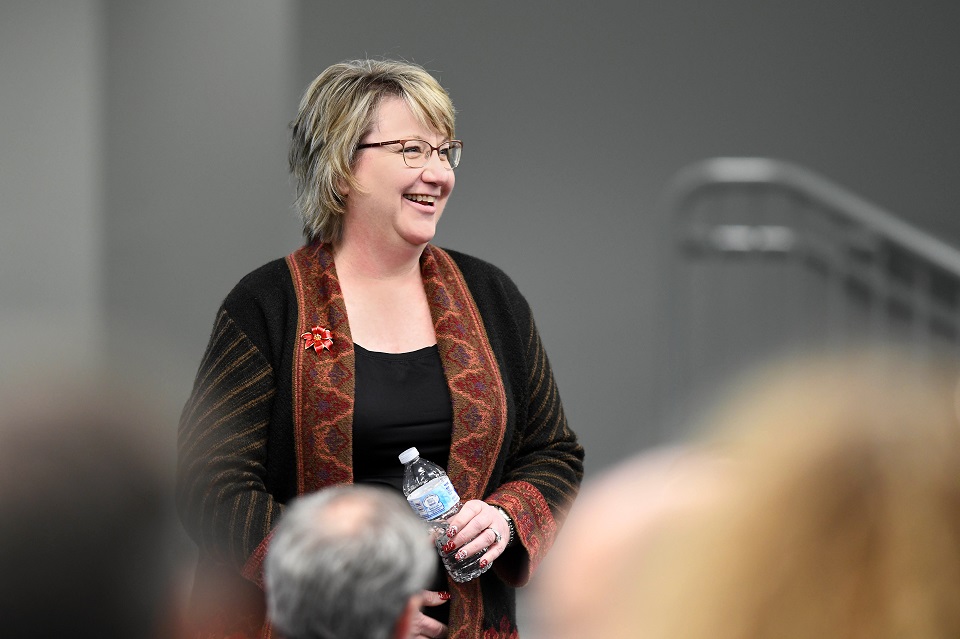
Learn more about CNS President and Chief Executive Officer Michelle Reichert. Please note the photo was taken in 2019, prior to the pandemic.
Take 5 minutes and learn more about Michelle Reichert, CNS's president and chief executive officer.
Michelle Reichert, CNS's president and chief executive officer, is a familiar face, even when it is behind a mask. She was part of the original CNS executive leadership team, but her experience at Pantex and Y-12 precedes the current contractor. Reichert came to Y-12 straight from graduate school, and she gained valuable experience during her 22 years at Y-12. She has been in senior leadership roles at Pantex since 2013.
“My background is varied — Production, ES&H, program management — and I view that as a strength,” she said. Others must too, because in 2020, Reichert became the first woman chief executive officer at Pantex or Y-12, and one of the first in the position within the Nuclear Security Enterprise.
An early adopter and fervent champion of change management (the people side of change), Reichert has demonstrated her commitment to employees as well as continuous improvement throughout her CNS tenure. Read on to learn more about Reichert’s early career aspirations, what she’s cooking up next, and her advice to new employees.
Are you doing what you envisioned as a young adult? If so, describe how you got here.
Ha! Not even close. I thought I would be a performance musician. I played the flute and really enjoyed it. But, I continued in the sciences while in college, and I was good in that area, too. When a fellow student received a summer internship at the University of California at Berkeley, I was really motivated to learn more about internships — and that initially fueled a continued pursuit of sciences. In fact, my first internship was at the Hanford Site in Richland, Washington.
What CNS principle drives you to be successful?
Continuous improvement — because it is vital to meeting the national security priorities of our country. We’re improving our infrastructure to improve working conditions for our employees and enable us to meet our deliverables for the long term; we’re improving ourselves as leaders and employees; and we have teams looking at our processes.
What one thing would your coworkers be surprised to know about you?
In college, I enjoyed — and excelled at — biology, particularly the study of human anatomy and physiology. The courses all involved dissection (yes, including humans), and I found learning about how the body works to be fascinating. Once I put aside my dreams to be a concert flautist, I thought about becoming a forensic pathologist. The Kay Scarpetta detective novels and perhaps the television show Quincy, M.E. (I’m sure many reading this won’t know who Quincy was — just think about the TV show Bones) may have influenced this possible career choice.
What’s your favorite outside of work activity and why?
Family is very important to me, so I’m often catching up with everyone outside of work. I also really enjoy cooking, and we’re all big fans of America’s Test Kitchen and the British Baking Show. Both cooking and family help me unwind. I cook almost every night. Dan, my husband, says he can tell how my day was by how aggressively I chop the vegetables!
What advice would you offer to someone who is starting their career?
Really get engaged — not just with your job, but also in your community or perhaps an affinity group. These other connections will give you a broader perspective beyond your daily responsibilities. Find your passion — both on and off site — then have a plan. Don’t sit on the sidelines. Your perspective is important, so engage, offer your ideas, and stay involved.
I am mission success: Bill Tindal
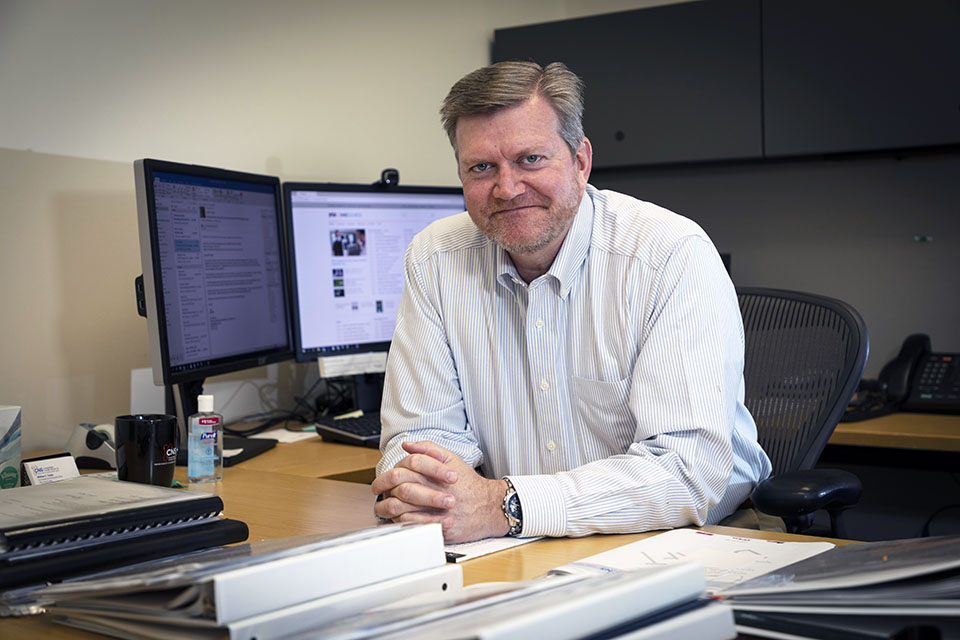
Learn something new about Bill Tindal, CNS’s chief operating officer.
Take 5 minutes and learn more about Bill Tindal, CNS’s chief operating officer.
When Bill Tindal joined Y-12 in 1995, being the chief operating officer for the management and operating contractor that now manages two sites and has about 10,000 employees didn’t even cross his mind.
“There are many times I thought I had reached the pinnacle of my career,” Tindal said. “When I look back on my roles, I would have been happy with several of those being my top stop — being the production manager of Building 9212 or being the vice president of production.”
During his 25 years, he’s grown along the way and keeps those lessons learned close at hand. “I think with each role I’ve had, I understand a little more that we all have important work to do. In my early days, I always thought the most important work being done on site was what I was doing, but then as I learned about the amazing work being done in other areas and organizations, I began to see how each role contributes a piece to the puzzle. I realized I was playing a small role in a much bigger picture.”
This sentiment — that every one of us has a role that contributes to the national security mission — is something Tindal has always been vocal about and something he wants everyone to appreciate.
“Through my experience, I have learned there are no unimportant jobs at either site. They are all important,” he said. “If one doesn’t work properly, it affects another group, which affects another, and so on. Pantex and Y-12 are part of an even larger whole, and we all have to do our part for the Nuclear Security Enterprise to be successful.”
Tindal said we often feel as if our piece is the most important part, but without all sites within the NSE working together, we wouldn’t accomplish the National Nuclear Security Administration’s goals.
“Asking for help and recognizing I don’t have all the answers is important,” Tindal said. “There are a lot of great people at Pantex and Y-12. Be humble, and ask for help when you don’t understand. If you really care about mission success, you have to stop and make sure you understand what people mean, especially when going into a new position.”
As COO, Tindal now travels to Pantex and has learned (and continues to learn) more about its missions and people.
“One thing that is different is each site’s lingo, but I’m improving,” he said. “One constant at both sites is the quality of the people. All are passionate and willing to help. Pantexans have the same passion and interaction that Y-12 employees have. I’ve always felt at home at either site.”
What advice would you give to your 1995, new hire, self?
What may feel like an immense challenge is really an opportunity to gain experience. Challenges (readiness reviews, frustrations with equipment) may be frustrating, but recognize that doing the right thing is rarely the easiest path.
What advice would you offer to someone who is starting their career?
Don’t be afraid to ask why. Ask why and how your job fits into mission success.
Don’t be afraid to fail. Each bad day turns out to be something we learn from. In my office, I have a bookshelf where I have mementos that remind me of lessons learned from risks or challenges we’ve faced. One of those items is a piece of quartz glass that was part of the first microwave project. We learned several things during that project, and the trinkets on my shelf remind me of the good and bad days.
What’s your top bucket list item and why?
When I retire and COVID is behind us, my wife and I want to complete the Great Loop. We hope to take a year to complete the 6,000-mile continuous boat route of connected waterways that allow you to boat completely around the eastern United States, starting in Tennessee.
A viral target: Cyberattacks on COVID-19
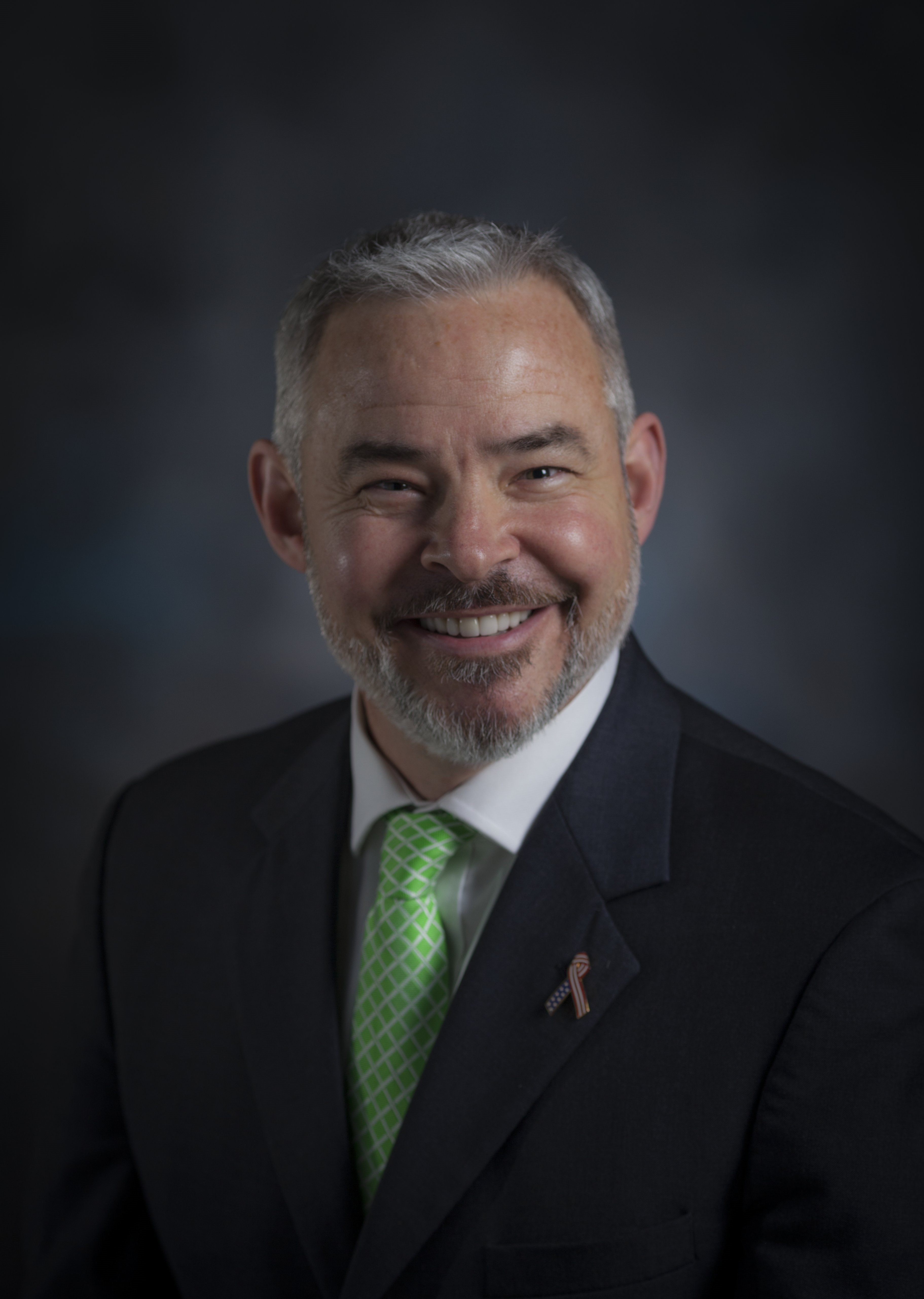
Paul Beckman,
Chief Information Security Officer
With peaked interest surrounding the coronavirus vaccine, cybercriminals are determined to exploit our feelings or anticipation in the form of social engineering. Reports have shown cyber threat actors baiting potential victims with vaccine-themed scams.
Examples of these scams include phishing emails holding varying subject lines that may reference surveys, information about vaccine coverage, locations to receive the vaccine, ways to reserve a vaccine, and vaccine requirements. Additionally, malicious links or attachments included in these phishing campaigns may impersonate familiar and trusted entities or brands.
You are the first line of defense in protecting your digital resources. In building your guard, it is important to be vigilant of the signs of cyber threats, keep a questioning attitude, and remain aware of protective criteria.
- Never open an email or hyperlink from an unknown sender.
- Be wary of unknown phone calls or robocalls that claim you have a problem, request financial information, or offer help. Most companies do not call users to notify you of a problem or to verify your financial data.
- If you’ve received a hyperlink that seems suspicious, hover your mouse over the link to view the link’s web address and verify that it isn’t directing you to a different or unknown website.
- Avoid clicking on pop-up messages or hyperlinks out of curiosity involving controversial topics. Hackers take advantage of people’s emotional decisions and often use curiosity as a tactic.
To bee or not to bee…
Pantex is home to a diverse wildlife population. From large and small mammals, birds, reptiles, and amphibians, down to the tiniest insect, just about any creature that calls the Panhandle home, is right out our back door. We keep interactions down to a minimum, but the occasional swallow or curious snake encounter has to be addressed.
Recently, our wildlife biologist found himself and two other employees having to deal with a large population of bees. They were becoming increasingly agitated by weed eaters and yard equipment. So, biologist Jim Ray, along with Monty Schoenhals and plant employee/bee keeper Joe Froeschle, had the formidable task of moving the hive from its location just outside the northern boundary of Playa 1 in a drip irrigation system, with minimum injury to themselves or the bees.
“This hive created a safety hazard for personnel that access the valve box for operation and maintenance of the irrigation system, “according to Pantex Wildlife biologist, Jim Ray. “In fact, the hive was discovered when several personnel operating weed-eaters were chased out of the area by the bees. The workers received several stings.”
A typical hive contains between 50,000 and 80,000 bees, and best guess is this one fell into that category. Using a homemade bee extractor out of a shop-vac, the bees were gathered up and re-located to Joe’s house, to join his other colonies. They believe the queen was extracted without harm, since bees swarm to their queen wherever she is and the relocated honey gatherers appear to be going about their business.
“Whenever a hive is encountered our first consideration is whether or not the hive is accessible to where we can remove it and transfer it to a beekeeper,” according to Ray.
Bees are considered an indicator of how well or how poorly the local environment is faring. As pollinators, bees play a part in every aspect of the ecosystem. They support the growth of trees, flowers, and other plants, which serve as food and shelter. In fact, pollinators like bees, play a key role in one out of every three bites of food we eat. Without them, many plants we rely on for food would die off.
“Our choice to spare this hive and transfer it into the care of a beekeeper is within the spirit of national pollinator initiatives, where federal agencies have been tasked to protect and promote pollinators – pollinators support entire ecosystems and many species of pollinators are in decline,” added Ray.
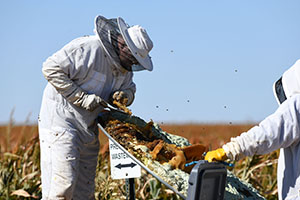
The relocation of this hive is considered a success. The newly-homed pollinators are settling into their new digs alongside other bees, Pantex workers who were at risk from bees due to their proximity while performing work are safe, and though it’s hard to believe by looking at the photos and the sheer number of bees involved, but the three completed the task, without issue.
The hive/honeycomb were found on the underside of a wastewater lid.
Using a homemade bee removal shop-vac tool, the bees were vacuumed up and moved to Joe’s house to join other hives.
The honeycomb is also removed while bees swarm around the collectors.
A small portion of the bee colony that was re-located for the Pantex workers’ safety and theirs.
Pantex adds new emergency vehicles to its fleet
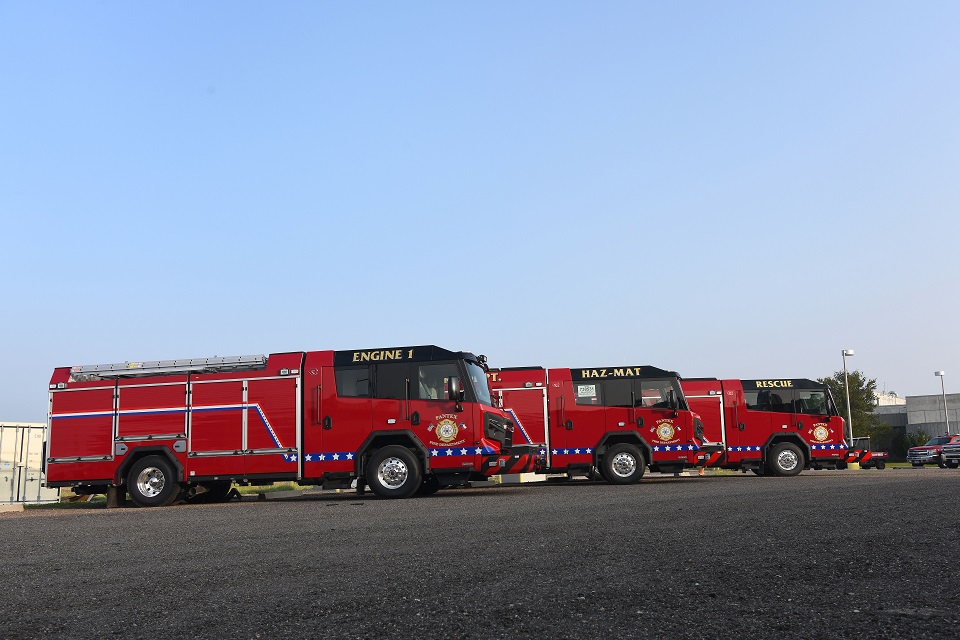
Pantex’s new firetrucks await duty
Very soon after the John C. Drummond center opened in 2018, Pantex got a new firetruck, the only one of its kind in the U.S. and only second worldwide at the time. It was designed to take a rescue crew up over the ledge of the roof of the JCDC and then articulate back down to the roof to assist in rescues. Now, the Pantex Fire Department is again adding to its growing fleet with three new unique trucks being brought into the fold.
The new trucks are each designed for different response capabilities. They provide Pantex firefighters with reliable vehicles to put out fires, make rescues, mitigate hazardous material releases, and save lives on plant site while helping our mutual aid partners.
First, a traditional structure fire engine, is replacing one that’s more than 25 years old. It is a multipurpose vehicle with firefighting and rescue capabilities related to fires and motor vehicle accidents.
The second unit eliminates a truck almost 30 years old and will be used for heavy rescue and major motor vehicle accidents, along with rescues with extreme angle elevations, towers, trench rescues, and a building collapse. It will be used for highway rescue operations on major roads as well as the county roads in Carson, Potter, and Armstrong Counties.
Finally, the third is a hazardous materials unit, designed to replace a heavy rescue unit from 1986, which was re-purposed in 2003 for hazardous material. This unit will respond to hazmat releases and spills as its primary function to define chemicals including the stop, release, and isolation of the substance. It will have the capability to carry level A and B hazmat suits and equipment for decontamination of firefighters and patients.
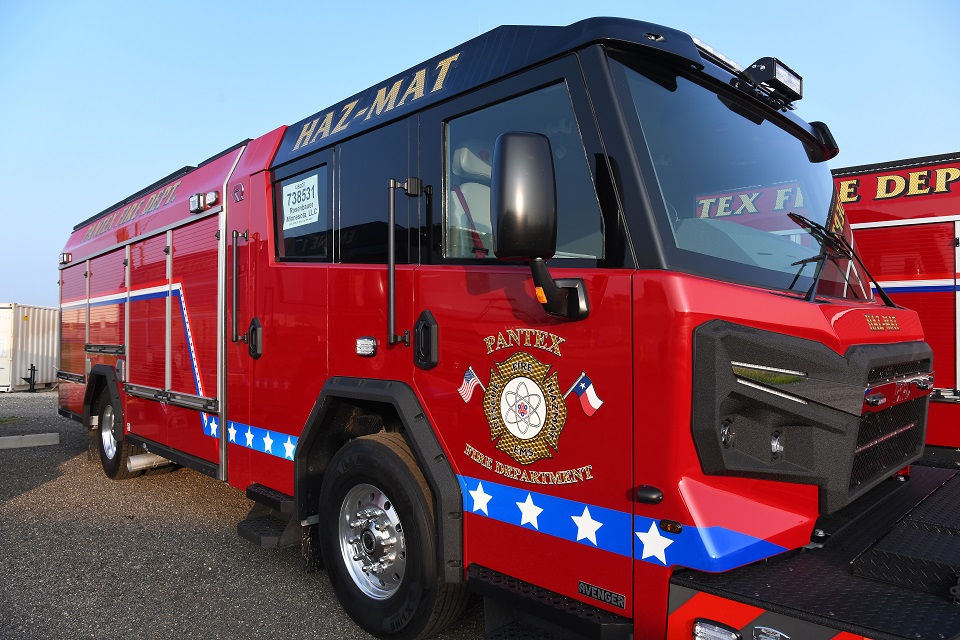
The new hazardous materials truck
According to Daniel Gleaves, Pantex Emergency Services Senior Director, “The addition of these new fire apparatus significantly enhances responder safety and response capability for both the site and the surround community, which will in return prevent injuries to our Firefighters and potentially save lives both on and off site.”
The ergonomic designs, and new unit’s safety features inside the passenger compartment area, chevron reflectors, and LED lights will help keep Pantex Firefighters safer when they are responding to emergencies in these new vehicles, too.
“These trucks allow us to provide modern vehicles that incorporate the best features for providing service to the community and safety for our personnel. The design of the trucks allows us to provide better, more efficient service to the plant and our mutual aid partners,” added Pantex Fire Chief Mike Brock.
With the addition of the new apparatus and on-board life-saving equipment, the Pantex Fire Department offers dependable response capabilities for years to come with reduced maintenance costs due to new design and parts availability. The new firetrucks also help fulfill our mutual aid agreement with nearby towns and cities to respond and assist when requested to do so.
